

COMET OF THE WEEK
WEEK 29: JULY 12-18
COMET SHOEMAKER-LEVY 9 1993e
Perihelion: 1994 April 18.57, q = 5.380 AU
On the night of March 23-24, 1993, the second night of a planned observing run at Palomar, clouds began to interfere, but rather than shut down for the night the team decided to use some light-damaged film. They succeeded in taking a handful of photographs of a region of sky around Jupiter (then near opposition) before being completely clouded out shortly after midnight, and upon scanning one of the last-taken sets of photographs two days later Carolyn discovered what she called a “squashed comet” – a diffuse 13th-magnitude object which, instead of a circular coma with perhaps a tail attached, appeared as a straight bar approximately one arcminute long. The team was able to get confirmation of the object from James Scotti with the Spacewatch program in Arizona, who reported the comet as appearing as a “train” of several discrete nuclei, each with their own tails, and with a broad fan of material extending well off to either side of this “train.” A few nights later images taken from Mauna Kea by Jane Luu and David Jewitt showed at least 17 separate nuclei, in their words “strung out likes pearls on a string.”
The comet was located approximately four degrees from Jupiter and moving in roughly the same speed and direction as that planet. Orbital calculations proved quite problematical for some time, but eventually it became clear that the comet was actually in an elongated orbit around Jupiter as opposed to the sun – a phenomenon that was first identified in the early 1980s but never exhibited in so dramatic a fashion. The calculations soon showed that on July 7, 1992, the comet had passed just 43,000 km above the top of Jupiter’s atmosphere, close enough such that the tidal forces from Jupiter’s gravity were stronger than the internal strength of the comet’s material, thus ripping it apart into over 20 fragments. It turned out that Swedish astronomer Gonzalo Tancredi had taken photographs of Jupiter’s vicinity in March 1992 for the deliberate purpose of searching for comets, but these didn’t reveal any sign of Comet Shoemaker-Levy 9 down to 21st magnitude, suggesting that – not unexpectedly – it had brightened dramatically as a result of its splitting during its close approach to Jupiter.

 LEFT: Comet Shoemaker-Levy 9, as imaged with the 0.9-meter Spacewatch telescope in Arizona on March 30, 1993. Courtesy James Scotti. RIGHT: The individual nuclei of Comet Shoemaker-Levy 9, as imaged by the Hubble Space Telescope on May 17, 1994. Courtesy NASA.
LEFT: Comet Shoemaker-Levy 9, as imaged with the 0.9-meter Spacewatch telescope in Arizona on March 30, 1993. Courtesy James Scotti. RIGHT: The individual nuclei of Comet Shoemaker-Levy 9, as imaged by the Hubble Space Telescope on May 17, 1994. Courtesy NASA.
What was even more exciting was that calculations began to reveal that when the comet fragments next returned to Jupiter’s immediate vicinity – during the third week of July 1994 – each of them would impact the planet. For the first time, humanity would have the opportunity to witness a comet striking a planet. The one downside was that the impacts would occur on the side of Jupiter facing away from Earth, although due to Jupiter’s rapid rotation the impact sites would rotate into view within a few minutes. One observer that would have a direct view of the impacts was the Galileo spacecraft, at that time en route to Jupiter (where it would arrive in late 1995) and located 1.6 AU away.
After being hidden behind the sun for the last several months of 1993 the comet reappeared in the morning sky towards the end of that year, and throughout the first six months of 1994 the nuclei slowly spread apart as they approached Jupiter. The first fragment – nucleus “A” – struck Jupiter on July 16, and although nothing was detected visually, ground-based observers using infrared telescopes almost immediately detected a bright flash at the expected location on Jupiter’s limb behind which the impact would have occurred. Meanwhile, the Hubble Space Telescope detected a short-lived plume extending up from Jupiter’s limb which then spread out into a characteristic mushroom-cloud shape. A few minutes later, when the impact site rotated into view it was clearly marked by a large black “scar” situated on Jupiter’s cloud bands.
For the next six days, until the last fragment – nucleus “W” – made its impact into Jupiter on July 22, the world watched as nucleus after nucleus struck the planet. Even some of the nuclei that had supposedly “disappeared” during the intervening month produced observable impact events, and meanwhile the largest fragment – nucleus “G,” which struck on the 18th – produced an impact flash bright enough to saturate the ground-based detectors and left an impact “scar” that was significantly larger than Earth.
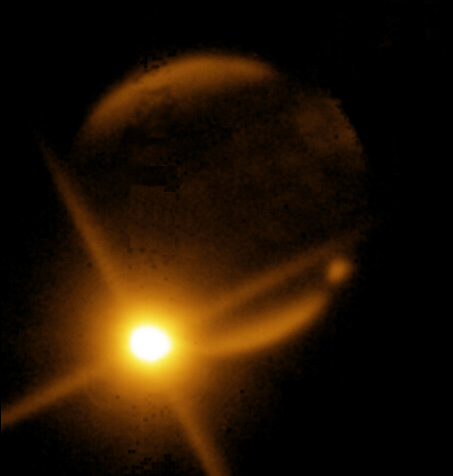
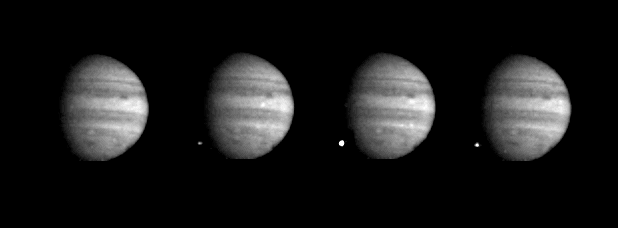 LEFT: Infrared image of the impact of nucleus “G” on July 18, 1994, taken by Peter McGregor from Siding Spring Observatory in New South Wales. Image courtesy Mount Stromlo and Siding Spring Observatories. RIGHT: Sequence of images of the impact of nucleus “W” on July 22, 1994, from the Galileo spacecraft. Courtesy NASA.
LEFT: Infrared image of the impact of nucleus “G” on July 18, 1994, taken by Peter McGregor from Siding Spring Observatory in New South Wales. Image courtesy Mount Stromlo and Siding Spring Observatories. RIGHT: Sequence of images of the impact of nucleus “W” on July 22, 1994, from the Galileo spacecraft. Courtesy NASA.
It turns out that these “scars” – which were easily detectable even with small backyard telescopes – were created when a fragment, traveling at a relative speed of 55 km per second, struck the atmosphere and disintegrated, briefly heating up the surroundings to temperatures exceeding the surface of the sun. The plumes that were ejected upwards included material from the disintegrated comet as well as material excavated up from the atmosphere, and reached a height of roughly 3000 km above the top of the atmosphere before quickly spreading out over a large area and settling down onto the tops of the clouds. The “scars” persisted for several weeks, although they eventually began to smear out due to Jupiter’s atmospheric winds, and when Jupiter reappeared in the morning sky near the end of 1994 following conjunction with the sun the various “scars” had smeared out into a dark band that encircled the planet. This faded steadily over the subsequent weeks and months, although I could still faintly detect it in July 1995, a full year after the impacts.
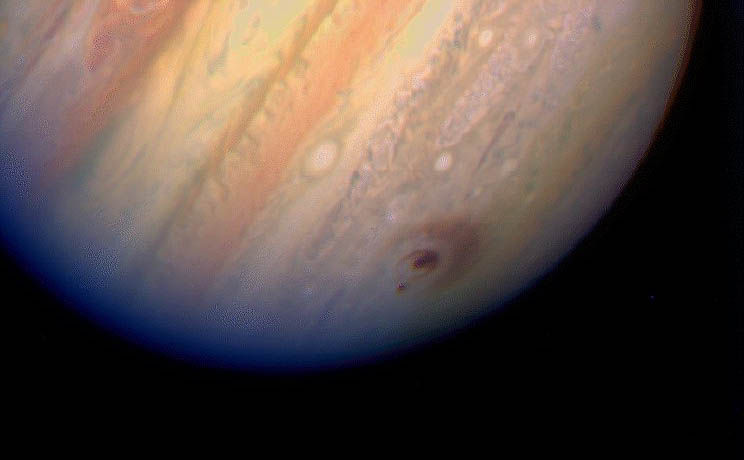
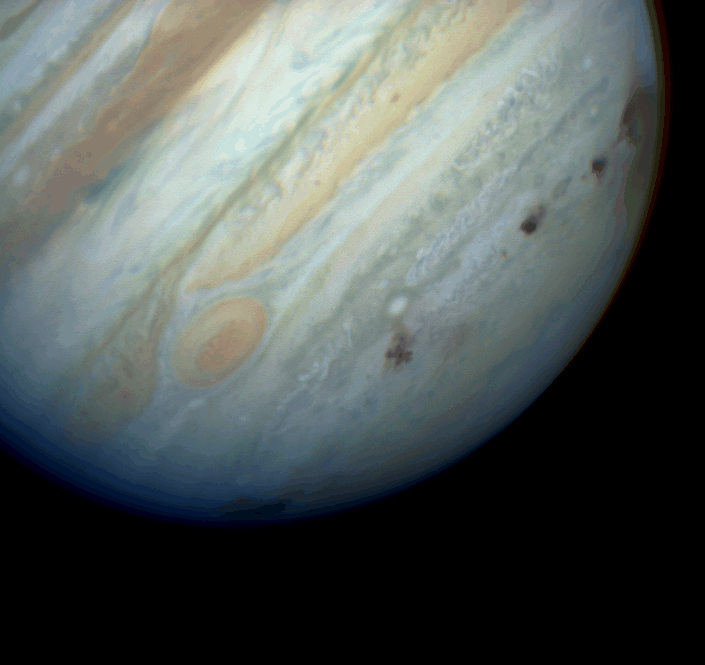 Hubble Space Telescope images of Comet Shoemaker-Levy 9 impact “scars.” Left: Impact “scar” of nucleus “G;” the “scar” is larger than Earth. Right: Multiple impact “scars.” Both images courtesy NASA.
Hubble Space Telescope images of Comet Shoemaker-Levy 9 impact “scars.” Left: Impact “scar” of nucleus “G;” the “scar” is larger than Earth. Right: Multiple impact “scars.” Both images courtesy NASA.
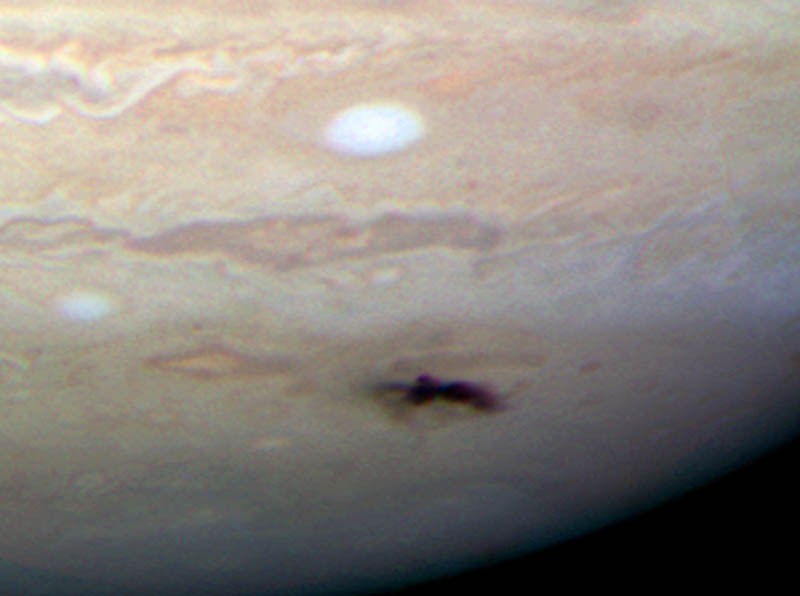
“chains” of craters on Jupiter's moons Ganymede and Callisto, suggestive of multiple impact events like those produced by Comet Shoemaker-Levy 9.
The ultimate lesson of the Shoemaker-Levy 9 impacts for many people was in the sheer energy of the impacts. The largest impact – from nucleus “G” – appears to have liberated close to six million megatons of energy, and all this from a rather small object; the total diameter of the original comet was probably no more than about 5 km. While Jupiter was the target this time, it could be Earth next time, and with the recent realization that the K-T extinction event that marked the demise of the dinosaurs was likely due to an impact, public awareness about the threat due to impacts climbed rapidly. The U.S. Congress commissioned Eugene Shoemaker to chair a commission to examine this issue and provide appropriate courses of action; the report that the Shoemaker Commission delivered to Congress and to NASA in June 1995 concluded that identification of threatening objects was the top priority, and this has in large part led to the comprehensive survey programs that first became operational in the late 1990s and that are continuing today – and that are discussed in next week’s “Special Topics” presentation.
“Comet of the Week” archive
Ice and Stone 2020 home page
Earthrise Institute home page